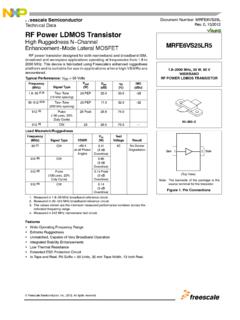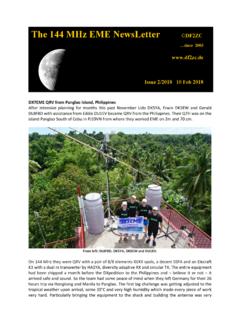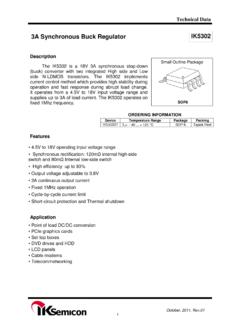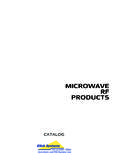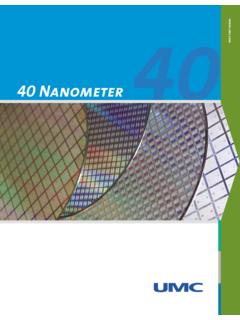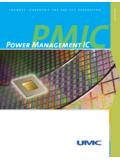Transcription of History of FET technology and the move to NexFET™
1 44As the power MOSFET s performance improved, it followed the evo-lution of CMOS technology introduced in the late 70s to produceintegrated circuits. Typically, power FET technology uses depreciatedCMOS foundries, following the leading edge with a time delay in theorder of three-to-five years with a feature size of: 1 m, m, m, m, m, m, etc. Geometry scaling leads todrop-in supply voltage of very large scale integrated (VLSI) circuitsused in electronic applications like computing, portable electronicsand telecommunications. As a consequence, power supply convertertopologies moved towards lower voltage, higher current and a needto better control the power level delivered to the first-generation of macrocell power MOSFET transistors, double-diffused MOSFET (DMOS), was successfully introduced into the mar-ket in the early 80s by International Rectifier.
2 This technology was avertical MOSFET with a planar gate structure, known as planarpower MOSFET. The second-generation of macrocell technology ,TrenchFET introduced by Siliconix, became popular in the 90s. Thistechnology delivered an improved switch resistance (RDSON). Trench-FET technology has a clear superiority over DMOS in terms of resist-ance and gate charge for a specific product when designed for adrain voltage capability lower than 100V. The dominant low-voltagetechnology in the market today, nearly all power MOSFET suppliersoffer it. Low-switch resistance reduced the conduction power loss inthe supply circuits. However, switching loss, which is very importantin switch-mode power supply (SMPS), remained the main the end of 90s, in order to reduce cost, size and improve per-formance such as transient response of the whole power manage-ment system, the converter s switching frequency needed to third-generation of macrocell power MOSFET technology recentlyintroduced by Texas Instruments, NexFETTM technology , offers aspecific RDSON competitive to the TrenchFET, which reduces theinput and Miller capacitances significantly.
3 Low capacitances meanlow input gate charge and short voltage transients during new generation MOSFET reduces switching losses in SMPS applications and enables operation at high switching technology is most advantageous at 30V and below, which isdesirable for distributed bus architectures prevalent in today s GenerationsThe difference between DMOS and TrenchFET transistors is illustrat-ed in Figure 1. A DMOS device has a planar gate structure and takesadvantage of a vertical current flow between the source and drainelectrodes placed at the front and back side of silicon die. Currentflows under the planar gate, then turns down between the P-bodyregions and flows vertically through the epitaxial layer to the sub-strate.
4 The lightly doped epitaxial layer easily supports high break-down voltage. Vertical current flow allows large current densities tobe handled as opposed to the difficulties in scaling up the area ofMOSFETs with lateral layout. The basic cell s pitch or lateral dimen-sion is relatively wide in order to keep enough spacing between theP-body regions. Large spacing is important to minimize the JFET effect created by thebody regions to opposed PN junctions. The DMOS transistor s RDSONis built up by the channel region s resistive contributions underneaththe gate, the JFET effect between P-body regions, and the epitaxiallayer s and substrate s resistance. The higher the breakdown voltagedesigned into the device, the larger the epitaxial layer s resistive con-tribution.
5 In a device designed for low-voltage applications, the MOSchannel s resistive contribution and JFET region are becoming a TrenchFET, the MOS channels are designed along the verticalwalls of the trenches. This allows for a high density of channels persilicon unit. By removing the JFET structure, the cell pitch can bemade small, reducing the specific RDSON(MOSFET resistance perarea). In the late 90s, the transistor s low RDSON made TrenchFETMOSFETH istory of FET technology andthe move to NexFETTMThe advantage comes from the low-input gate chargeIntroduced as a substitute for bipolar transistors, power MOSFETs were used as an elec-tronic switch for power management applications.
6 A power MOSFET has a high inputimpedance. This means it is a voltage-controlled, unlike the current-controlled, bipolarswitch. In other words, a power MOSFET can achieve high switching speed even whenusing a low-power driver. With time, the power MOSFET became the most popular powerswitch for applications requiring input voltage lower than 200V. By Jacek Korec and Chris Bull, Power Stage Group, Texas InstrumentsBodo s Power Systems May 1: Comparison of planar DMOS and TrenchFET device structures technology a de facto standard area for low-voltage power MOS-FETs. However, the large trench wall area leads to a large value ofbuilt-in capacitors. When the trench bottom overlaps the epitaxiallayer, which is part of the drain terminal, it creates a large capaci-tance from gate-to-drain (CGD).
7 This is a major drawback, especiallyif a high switching speed is required. At the onset of the 21st century, the trend towards DC/DC converterswith higher switching frequencies ignited a demand to minimizeMOSFET-related switching losses. Developing TrenchFET structurescontinues. The first improvement incorporated a thick oxide at thetrench bottom, reducing the Miller capacitance (CGD) value. Evenmore significant improvement was achieved by splitting the gate elec-trode and connecting the lower part to the source terminal. The lowerpart of the gate electrode has a shielding effect, decoupling the gatefrom the drain to significantly reduce CGD. By mid-2000, this secondversion of the trench power MOSFET structure dominated low-volt-age power management third-generation or NexFET power MOSFETs delivers a break-through in the switch s dynamic performance (see Figure 2).
8 Thisdevice has its roots in the LDMOS transistor used for RF signalamplification in a frequency range up to 2 GHz. To achieve this levelof dynamic performance, it is critical to reduce the Miller capacitanceto single picofarads. The overlap of the gate electrode over the lightlydoped drain extension (LDD) is kept at a minimum. Additionally, theunique topology of the source metal wrapping the gate electrode andcreating a field-plate element over the LDD region makes an effectiveelectrostatic shield between the gate and drain field-plate created by the sourcemetal is also important in stretchingout the distribution of the electricfield along the LDD surface. Thisfeature lowers the height of the elec-tric field peak at the drain corner ofthe gate electrode.
9 By doing so, thehot-carrier effects of creating reliabil-ity issues in the conventionalLDMOS devices are avoided. TheLDD region itself is designed follow-ing the charge balance design , doping in the LDD region iscounter-balanced by the charge in the depleted deep-P region, and isadditionally influenced by the source field-plate. The charge balanceapproach allows the carrier concentration in the LDD region to beincreased by roughly one order of RDSONof NexFET devices take advantage of the short MOSchannel and short length of the highly doped LDD region. Moreover,the small cell pitch achieved by the contemporary fine line lithogra-phy makes the specific RDSONof NexFET devices competitive toTrenchFET technology .
10 The advantage of the NexFET approachcomes from the low-input gate charge and very low CDG values, notachievable with the TrenchFET technology provides excellent figure of merit (FOM) valuesso important for SMPS applications. The classic way to judge howgood a power MOSFET platform technology is in switching applica-tions is to look at the resistance multiplied by the total gate charge orthe Miller capacitance. The recent History of FOM improvements andbreakthroughs achieved by introducing NexFET technology is illus-trated by Figure 3. TrenchFET technology , after almost two decadesof development, shows a saturation effect in the tempo of the FOMimprovements. The NexFET approach, being at its early stage ofmaturation, promises on-going improvements for the level of improvement made possible by implementing NexFETdevices is demonstrated in Figure 4, which shows the efficiency of asix-phase synchronous buck 12V converter running at 635 kHz.










